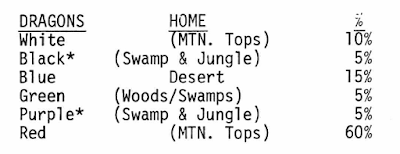Before his passing, Dave Arneson indicated that he wished to re-edit JG 37 "The First Fantasy Campaign", as reported in First Fantasy Campaign Belongs to Arneson Estate Bledsaw Confirms on Havard's Blackmoor Blog.
Although we can't know exactly what Arneson had in mind, having just completed a review of each section in "The First Fantasy Campaign", I have attempted to reorganize its contents, adopting the OD&D framework:
Special Interests- Definition of Terms- Examples- How to Become a Bad Guy- Egg of Coot- Ran of Ah Fooh- Gin of Salik- Marfeldt the Barbarian (A Short Biography)- Duke of the Peaks- The Blue Rider- Mello and the Hobbits (Mello's Hobbit House)- The Great Svenny (Svenson's Freehold)- The Bishop- Final Notes
- Dragons- Orcs- Bandits- Nomads- Trolls and Ogres- Wights (and Ghouls)- True Trolls- Rocs- Tarns- Basilisk- Balrog- Giants- Magic Swords Personality Matrix "Blackmoor"- Explanation- Combat Characteristics Table- Magic Characteristics Table- Special Characteristics Table- Sword Enchantments by Magic-Users- Holy Swords- Special Notes
Blackmoor- Population, Area, Resources, Ruling Class, The Country- Blackmoor Castle, The Pits, The Ruins, Wolf's Head Pass, The Comeback Inn- Blackmoor Military Manpower Distribution (Initial)
- The Blackmoor Castle's History- Haunted Rooms and the Like- The Black Hall- The Catacombs- The Tower- Haunted Rooms- Sir Fang- Elves- Dungeon Map Notes- Magic Protection Points- Wandering Monster Areas- Level Maps
Glendower Dungeons
- Sample of Playing Area- Description of an Area- Defense of Area- Encounters- Moves, Budget- Outdoors in Blackmoor- Migration- Drawing Your Own Map- Human Habitation- Area Pattern in Hexes- The Great Invasion- The Original Price/Unit Ratio List- Additional Weapon Cost/Limit- Additional Price Lists (Standard Castle Types)- Personnel Costs (in GP for 1 Year's Pay and Upkeep)- The Later Prices Lists- Earl of Vestfold- Northern Lords (Sea Raiders)- City of Maus- Regent of the Mines- Duchy of Ten- Minor Holdings of Ten - Nomads of Ten- Egg of Coot- Internal Investments- Roads, Bridges, Canals, Inns- Hunting, Armories and Animal Branding- Religion, Exploration- Ship Building, Farming, Fishing- Trapping, Tourism, Arrival of New Persons- Land & Sea Trade- Price List
- Gypsy Sayings- Legends- Chance Cards
- Differences in Creatures from Blackmoor Game- Population of Known Area- Wizard's Apprenticeship- The Languages- Hero and Superhero Flunkies- Vampires- An Explanation of Creature Psychology













